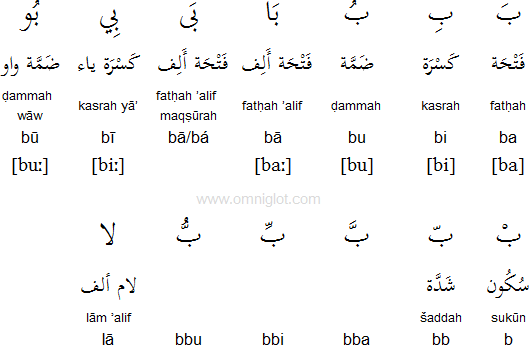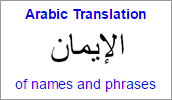What Does Arabic Writing Look Like
Arabic 
The Arabic script evolved from the Nabataean Aramaic script. It has been used since the 4th century AD, but the earliest document, an inscription in Arabic, Syriac and Greek, dates from 512 AD. The Aramaic language has fewer consonants than Arabic, so during the 7th century new Arabic letters were created by adding dots to existing letters in order to avoid ambiguities. Further diacritics indicating short vowels were introduced, but are only generally used to ensure the Qur'an was read aloud without mistakes.
There are two main types of written Arabic:
- Classical Arabic - the language of the Qur'an and classical literature. It differs from Modern Standard Arabic mainly in style and vocabulary, some of which is archaic. All Muslims are expected to recite the Qur'an in the original language, however many rely on translations in order to understand the text.
- Modern Standard Arabic (اللغة العربية الفصحى / al-luġatu l-ʿarabiyyatu l-fuṣḥā) - the universal language of the Arabic-speaking world which is understood by all Arabic speakers. It is the language of the vast majority of written material and of formal TV shows, lectures, etc.
Each Arabic speaking country or region also has its own variety of colloquial spoken Arabic. These colloquial varieties of Arabic appear in written form in some poetry, cartoons and comics, plays and personal letters. There are also translations of the bible into most varieties of colloquial Arabic.
Arabic has also been written with the Hebrew, Syriac and Latin scripts.
Notable Features
- Type of writing system: abjad / consonant alphabet
- Writing direction: words are written in horizontal lines from right to left, numerals are written from left to right
- Number of letters: 28 (in Arabic) - some additional letters are used in Arabic when writing placenames or foreign words containing sounds which do not occur in Standard Arabic, such as /p/ or /g/. Additional letters are used when writing other languages.
- Used to write: Arabic, Adamaua Fulfulde, Afrikaans, Arabic (Algerian), Arabic (Chadian), Arabic (Egyptian), Arabic (Hassaniya), Arabic (Lebanese), Arabic (Libyan), Arabic (Modern Standard), Arabic (Moroccan), Arabic (Syrian), Arabic (Tunisian), Arwi, Äynu, Azeri, Balanta-Ganja, Balti, Baluchi, Beja, Belarusian, Bosnian, Brahui, Chagatai, Chechen, Comorian, Crimean Tatar, Dargwa, Dari, Dogri, Domari, Gilaki, Hausa, Hazaragi, Indus Kohistani, Kabyle, Kalkoti, Karakalpak, Kashmiri, Kazakh, Khowar, Khorasani Turkic, Konkani, Kurdish, Kyrgyz, Lezgi, Luri, Malay, Mandinka, Marwari, Mazandarani, Morisco, Mozarabic, Nubi, Ormuri, Palula, Parkari Koli, Pashto, Persian/Farsi, Punjabi, Qashqai, Rajasthani, Rohingya, Salar, Saraiki, Sawi, Serer, Shabaki, Shina, Shughni, Sindhi, Somali, Tatar, Tausūg, Tawallammat Tamajaq, Tayart Tamajeq, Torwali, Turkish, Urdu, Uyghur, Uzbek, Wakhi, Wanetsi, Wolof, Xiao'erjing and a number of other languages
- Most letters change form depending on whether they appear at the beginning, middle or end of a word, or on their own. (see below)
- Letters that can be joined are always joined in both hand-written and printed Arabic. The only exceptions to this rule are crossword puzzles and signs in which the script is written vertically.
- The long vowels /a:/, /i:/ and /u:/ are represented by the letters 'alif, yā' and wāw respectively.
- Vowel diacritics, which are used to mark short vowels, and other special symbols appear only in the Qur'an. They are also used, though with less consistency, in other religious texts, in classical poetry, in books for children and foreign learners, and occasionally in complex texts to avoid ambiguity. Sometimes the diacritics are used for decorative purposes in book titles, letterheads, nameplates, etc.
Arabic script
Arabic consonants

The transliteration of consonants used above is the ISO version of 1984. There are various other ways of transliterating Arabic.
This chart shows how the letters change in different positions

Arabic vowel diacritics and other symbols

Hear how to pronounce the Arabic letters:
Arabic chat alphabet
When chatting online some Arabic speakers write in the Latin alphabet use the following letters:

More details
https://en.wikipedia.org/wiki/Arabic_chat_alphabet
https://books.google.co.uk/books
Download
Download an Arabic alphabet chart in Word or PDF format
Arabic numerals and numbers
These numerals are those used when writing Arabic and are written from left to right. In Arabic they are known as "Indian numbers" (أرقام هندية / arqa-m hindiyyah). The term 'Arabic numerals' is also used to refer to 1, 2, 3, etc.

The Arabic language
Arabic is a Semitic language with about 221 million speakers in Afghanistan, Algeria, Bahrain, Chad, Cyprus, Djibouti, Egypt, Eritrea, Iran, Iraq, Israel, Jordan, Kenya, Kuwait, Lebanon, Libya, Mali, Mauritania, Morocco, Niger, Oman, Palestinian West Bank & Gaza, Qatar, Saudi Arabia, Somalia, Sudan, Syria, Tajikistan, Tanzania, Tunisia, Turkey, UAE, Uzbekistan and Yemen.
There are over 30 different varieties of colloquial Arabic which include:
- Egyptian - spoken by about 50 million people in Egypt and perhaps the most widely understood variety, thanks to the popularity of Egyptian-made films and TV shows.
- Algerian - spoken by about 22 million people in Algeria
- Moroccan/Maghrebi - spoken in Morocco by about 19.5 million people
- Sudanese - spoken in Sudan by about 19 million people
- Saidi - spoken by about 19 million people in Egypt
- North Levantine - spoken in Lebanon and Syria by about 15 million people
- Mesopotamian - spoken by about 14 million people in Iraq, Iran and Syria
- Najdi - spoken in Saudi Arabia, Iraq, Jordan and Syria by about 10 million people
For a full list of all varieties of colloquial Arabic click here (format: Excel, 20K).
Source: www.ethnologue.com
Sample Arabic text (unvocalised)

Sample Arabic text (vocalised)

Transliteration
Yūladu jamī'u n-nāsi aḥrāran mutasāwīna fī l-karāmati wa-l-ḥuqūq. Wa-qad wuhibū 'aqlan wa-ḍamīran wa-'alayhim an yu'āmila ba'ḍuhum ba'ḍan bi-rūḥi l-ikhā'.
Listen to a recording of this text by زين العابدين شبيب (Zein Al-A'bideen Shabeeb)
Translation
All human beings are born free and equal in dignity and rights. They are endowed with reason and conscience and should act towards one another in a spirit of brotherhood.
(Article 1 of the Universal Declaration of Human Rights)
Sample videos in and about Modern Standard Arabic
Information about Arabic | Phrases | Numbers | Video lessons | Tower of Babel | Articles | Links | Learning materials | Books about the Arabic script | Arabic electronic dictionaries and translators
Links

Online Arabic lessons
http://i-cias.com/babel/arabic/
http://mylanguages.org/learn_arabic.php
http://www.madinaharabic.com
http://arabicspeaker.blogspot.com
http://www.arabic-alphabet.org
http://www.naturalarabic.com
http://www.dalilusa.com/arabic_course/intro.asp
http://www.arabicsp.com
http://www.arabicpod.net
http://www.arabic-studio.com
http://www.ArabicOnline.eu
http://www.laflwsp.com
http://www.criticallanguageservice.com/about-us/youtube-videos
http://www.learnarabic.com
http://ilovelanguages.org/arabic.php
http://lingohut.com/en/l69/learn-arabic
- Learn Arabic online with ArabicPod101
- TalkInArabic.com - learn colloquial Arabic of Algeria, Egypt, Iraq, the Levant, Morocco, Saudi Arabia, Sudan or Tunisia
- eArabic Learning - Learn Arabic Online with Live Teachers
- Learn Arabic with Glossika
- Learn Arabic now at Rocket Languages!
- Arabic Genie - a quick and easy way to learn the Arabic alphabet
Arabic courses and other resources available on Amazon
Experienced Arabic Tutors (tutorhouse.co.uk)
More Arabic-related links
How to read handwritten Arabic
https://autolingual.com/handwritten-arabic/
Varieties of Arabic
Algerian, Chadian, Cypriot, Egyptian, Hassaniya, Lebanese, Libyan, Modern Standard, Moroccan, Syrian, Tunisian
Semitic languages
Akkadian, Amharic, Arabic (Algerian), Arabic (Chadian), Arabic (Egyptian), Arabic (Hassaniya), Arabic (Lebanese), Arabic (Modern Standard), Arabic (Moroccan), Arabic (Syrian), Aramaic, Argobba, Assyrian / Neo-Assyrian, Canaanite, Chaha, Chaldean Neo-Aramaic, Ge'ez, Hadhramautic, Harari, Hebrew, Himyaritic, Jewish Neo-Aramaic, Maltese, Mandaic, Nabataean, Neo-Mandaic, Phoenician, Punic, Qatabanic, Sabaean, Sabaic, Silt'e, Syriac, Tigre, Tigrinya, Turoyo, Ugaritic, Western Neo-Aramaic
Languages written with the Arabic script
Adamaua Fulfulde, Afrikaans, Arabic (Algerian), Arabic (Chadian), Arabic (Egyptian), Arabic (Hassaniya), Arabic (Lebanese), Arabic (Libyan), Arabic (Modern Standard), Arabic (Moroccan), Arabic (Syrian), Arabic (Tunisian), Arwi, Äynu, Azeri, Balanta-Ganja, Balti, Baluchi, Beja, Belarusian, Bosnian, Brahui, Chagatai, Chechen, Comorian, Crimean Tatar, Dargwa, Dari, Dogri, Domari, Gilaki, Hausa, Hazaragi, Indus Kohistani, Kabyle, Kalkoti, Karakalpak, Kashmiri, Kazakh, Khowar, Khorasani Turkic, Konkani, Kurdish, Kyrgyz, Lezgi, Luri, Malay, Mandinka, Marwari, Mazandarani, Morisco, Mozarabic, Nubi, Ormuri, Palula, Parkari Koli, Pashto, Persian/Farsi, Punjabi, Qashqai, Rajasthani, Rohingya, Salar, Saraiki, Sawi, Serer, Shabaki, Shina, Shughni, Sindhi, Somali, Tatar, Tausūg, Tawallammat Tamajaq, Tayart Tamajeq, Torwali, Turkish, Urdu, Uyghur, Uzbek, Wakhi, Wanetsi, Wolof, Xiao'erjing
Consonant alphabets (Abjads)
Ancient Berber, Arabic, Aramaic, Hebrew, Manichaean, Nabataean, Pahlavi, Parthian, Phoenician, Paleo-Hebrew, Proto-Sinaitic / Proto-Canaanite, Psalter, Punic, Sabaean, Samaritan, Sogdian, South Arabian, Syriac, Tifinagh, Ugaritic
Other writing systems
Page last modified: 14.09.21

Why not share this page:

Get 3 months Audible membership for just 99p
If you need to type in many different languages, the Q International Keyboard can help. It enables you to type almost any language that uses the Latin, Cyrillic or Greek alphabets, and is free.
If you like this site and find it useful, you can support it by making a donation via PayPal or Patreon, or by contributing in other ways. Omniglot is how I make my living.

Note: all links on this site to Amazon.com, Amazon.co.uk
and Amazon.fr
are affiliate links. This means I earn a commission if you click on any of them and buy something. So by clicking on these links you can help to support this site.

What Does Arabic Writing Look Like
Source: https://omniglot.com/writing/arabic.htm
Posted by: doanewiteld.blogspot.com

0 Response to "What Does Arabic Writing Look Like"
Post a Comment